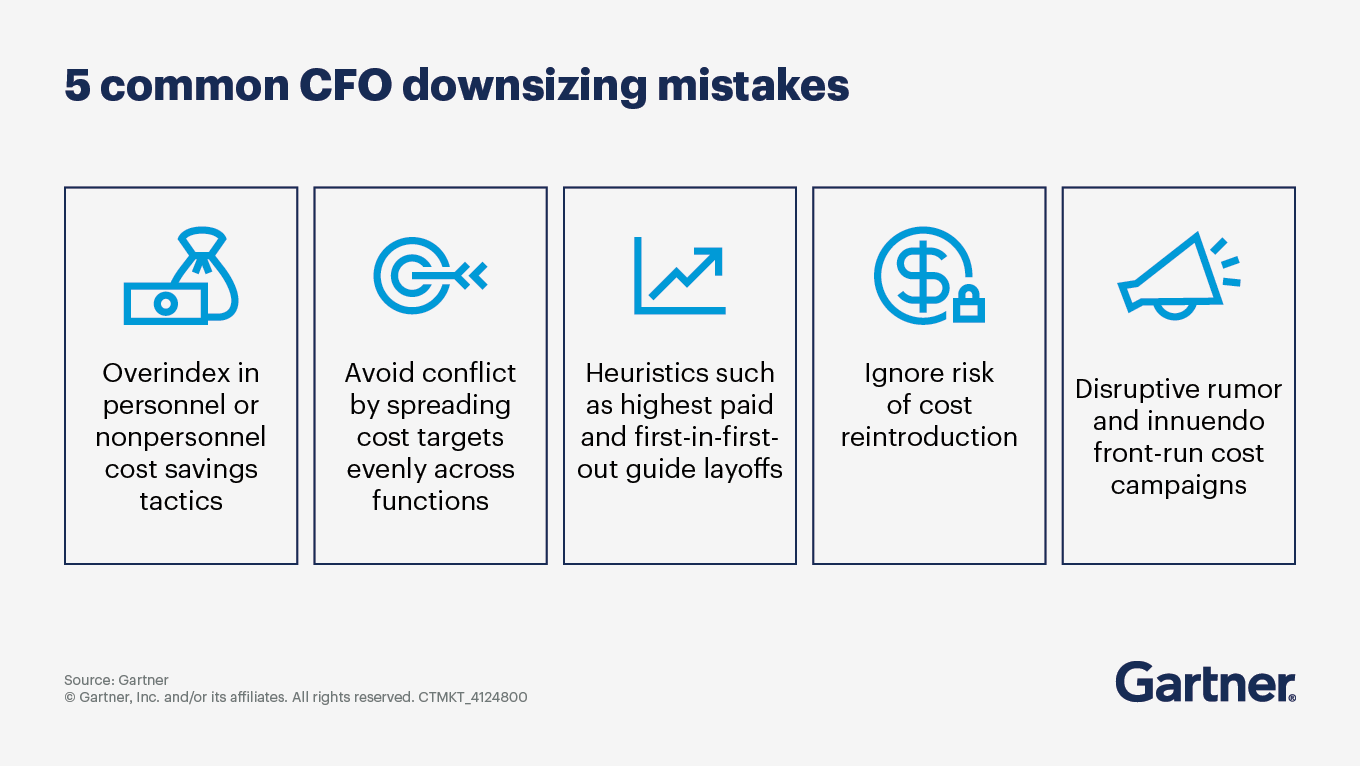CFOs considering layoffs as a cost-trimming measure must balance immediate financial pressures with the long-term performance of the organization and its people.
- Gartner client? Log in for personalized search results.
CFOs face tough choices in considering layoffs to cut costs
People costs account for a large percentage of functional and operational spend in most organizations — for instance, an average of 75% of the finance function budget. It’s not surprising, then, that these expenses are targeted during cost reductions.
But layoffs are not a simple solution. They may not deliver sustained savings and can introduce significant downstream risks. A mindful approach can help protect financial performance, immediate growth, organizational capabilities and longer-term strategic priorities.
Don’t be shortsighted when it comes to layoffs
Defend margins in the short term, but preserve the talent and capabilities required for long-term success when considering layoffs.
First explore cost savings outside of layoffs
Before pursuing layoffs, ensure budget holders have exhausted non-personnel cost-savings ideas and are steeped in a structured approach to cost management. This ensures that the organization is always looking to shift spend to protect value and prevents the need to ring the alarm when budgets are stressed.
This type of strategic cost optimization is the surest way to reduce costs without jeopardizing value and growth drivers. It can also help mitigate upfront expenses associated with layoffs (such as severance and legal costs).
If layoffs are unavoidable, target them strategically
Not all workforce expenses are created equal. Making across-the-board reductions overlooks the critical capabilities some functions hold, unfairly penalizes the more efficient parts of the business and weakens value overall.
Instead of applying headcount cuts evenly across functions, focus on how to meet expense goals while minimizing business disruption. Assess factors such as:
Strategic importance. Weigh the extent to which a function or team enables corporate strategy.
Opportunity to relocate roles. Hybrid and remote work create opportunities to source labor from alternative, lower-cost locations when rehiring.
Cost and headcount benchmarks. Functions or teams that are more costly or less efficient compared to industry peers may bounce back better from workforce reduction — but be cautious about reducing the size of already lean teams.
Ability to automate roles. Technologies like robotics process automation and AI create opportunities for functional leaders to temporarily eliminate specific roles in a downturn and then replace them with automated technology solutions as budget permits.
Give budgetholders self-service tools to inform downsizing decisions
Some leaders default to one-size-fits-all policies (such as last-in-first-out and highest-paid-first-out) when planning a layoff. This approach can do more harm than good. Gartner research shows that employees who exceeded expectations in recent performance reviews were (counterintuitively) 24% more likely to be made redundant than those who only met expectations — likely because they were also the most expensive talent.
Work cross functionally to equip and empower budgetholders with the tools and guidance they need to make financially and strategically informed layoff decisions. For example, HR often has access to detailed headcount and operational data, and legal often has access to industrial relations data that finance teams can only access in aggregate form.
A viable shortlist should:
Organize candidates according to how they align with future business strategy and their direct impact on revenue or performance.
Quantify the short-term costs (such as severance), ongoing cost savings and number and configuration of employees required to be laid off to meet cost-savings targets.
Reduce the risk of cost creep with tracking mechanisms
Poorly planned layoffs can result in contractor hiring, overtime and aggressive rehiring, which erodes cost savings and derails the best-laid optimization plans. A sustainable cost optimization strategy should include baseline tracking and governance of ongoing spend.
Work with HR leadership to develop a list of practical tactics that budgetholders can use to proactively minimize the risk of cost reemergence after a layoff.
Communicate rationale and financial impact transparently to retain critical talent
Without clear communication, workforce reductions can lead to fear, “survivor” guilt and damaging workplace rumors.
Partner with senior HR leadership, communications and industrial relations to develop and execute a communication strategy in two phases:
Pre-layoff communications to prepare management
Post-layoff communications to keep retained employees, especially top performers, engaged, focused and motivated
Be sure to convey both the financial rationale and the importance of continuity to maintain organizational performance and retain critical talent.
Cost cutting for CFOs FAQs
How should CFOs approach cost cutting in a volatile economy?
When considering how to optimize costs in a downturn, take the proven path forward: Systematically reduce unnecessary spend, optimize enterprise performance and invest in future sources of value.
What are some common mistakes for CFOs to avoid when planning a workforce reduction as part of a larger cost-cutting strategy?
Common workforce reduction mistakes include rushing to cut personnel expenses without considering non-personnel options; evenly cutting costs across every function; following rigid, one-size-fits-all rules when creating a downsizing shortlist; ignoring potential cost creep; and allowing disruptive rumors and sentiments to proliferate by failing to communicate effectively.
Attend a Conference
Join Gartner experts and your peers to accelerate growth
Gather alongside your peers in National Harbor to gain insight on emerging trends, receive one-on-one guidance from a Gartner expert and create a strategy to tackle your priorities head-on.
Gartner Finance Symposium/Xpo™
National Harbor, MD

Drive stronger performance on your mission-critical priorities.
